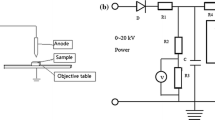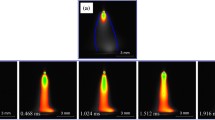Abstract
In this work, tungsten–copper (W–Cu) alloy with multi-scale tungsten phase was prepared by cold isostatic pressing, vacuum sintering and hot extrusion processes. The microstructure of W-70Cu alloy was examined by scanning electron microscopy and transmission electron microscopy. The arc erosion resistance of W-70Cu alloy was studied in the JF04C electrical contact testing system. The erosion morphology of the contact surface was characterized. The action mechanism of tungsten particles in arc erosion process was discussed in detail. The arc erosion property and mechanism of W-70Cu alloy were analyzed. The results show that the material transfer occurs from the cathode to the anode. With enhancing the current and voltage, the arcing time and arcing energy increase while the contact resistance falls slightly. In the arc erosion process, tungsten particles increase the work function of W–Cu alloy and make the arc disperse better. The large tungsten particles in W–Cu contact can help to maintain the shape of the contact and delay the occurrence of fusion welding. Tungsten nano-particles enhance the viscosity of the molten pool, reduce metal splashing, and hinder the crack initiation and propagation. Under the action of multi-scale tungsten particles, W–Cu alloy has the better resistance to arc erosion.














Similar content being viewed by others
References
Wang XG, Zhang HL, Li WJ, Liu LL (2015) Effect of preparation process on micro-structure and arc-erosion resistance of WCu30 alloy. Rare Metal Mater Eng 44:140–145
Wang YL, Zhuo LC, Yin EH (2021) Progress, challenges and potentials/trends of tungsten–copper W–Cu composites/pseudo-alloys: fabrication, regulation and application. Int J Refract Metals Hard Mater 100:105648
Li YG, Liu LM, Li J (2011) The progress of W–Cu composite materials preparation technique. In: International conference on materials for renewable energy and environment, Shanghai, pp.1346–1349
Dong LL, Ahangarkani M, Chen WG, Zhang YS (2018) Recent progress in development of tungsten–copper composites: fabrication, modification and applications. Int J Refract Metal Hard Mater 75:30–42
Wang WS, Hwang KS (1998) The effect of tungsten particle size on the processing and properties of infiltrated W–Cu compacts. Metall Mater Trans A 29:1509–1516
Johnson JL, Brezovsky JJ, German RM (2005) Effects of tungsten particle size and copper content on densification of liquid-phase-sintered W–Cu. Metall Mater Trans A 36:2807–2814
Ahangarkani M, Zangeneh-Madar K (2018) Investigation on the microstructure and properties of W-10wt% Cu prepared by sintering and infiltration. Int J Refract Metal Hard Mater 75:1–9
Samei J, Green D, Stoilov V (2011) Fabrication of W-12wt%Cu composites by powder metallurgy method: activated sintering. Adv Mater Res 409:209–214
Johnson JL (2015) Activated liquid phase sintering of W–Cu and Mo-Cu. Int J Refract Metal Hard Mater 53:80–86
Ibrahim A, Abdallah M, Mostafa SF, Hegazy AA (2012) An experimental investigation on the fabrication of W–Cu composite through hot-press. Int J Indus Chem 3:10
Liu BB, Xie JX, Qu XH (2008) Fabrication of W–Cu functionally graded materials with high density by particle size adjustment and solid state hot press. Compos Sci Technol 68:1539–1547
Elsayed A, Wei L, Kady OE, Daoushc WM, Olevsky EA, German RM (2015) Experimental investigations on the synthesis of W–Cu nanocomposite through spark plasma sintering. J Alloy Compd 639:373–380
Kamal SK, Sushmam Y, Vimala J, Shankar B, Ghosal P, Durai L, Majumdar B (2019) Effect of processing route on densification of W-10 wt% Cu nanocomposite using spark plasma sintering. J Alloy Compd 785:1137–1143
Hou C, Song XY, Tang FW, Li YR, Cao WJ, Nie ZR (2019) W–Cu composites with submicron and nanostructures: progress and challenges. NPG Asia Mater 11:74
Zhang Q, Liang SH, Hou BQ, Zhuo LC (2012) The effect of submicron-sized initial tungsten powders on microstructure and properties of infiltrated W-25wt% Cu alloys. Int J Refract Metal Hard Mater 59:87–92
Gao HM (2017) Influence of particle size on microstructure properties and arc ablation characteristics of tungsten–copper alloys. Master dissertation, Xi’an University of Technology
Li ZY, Li SJ, Li BH, Wang F, Tong J, Su HB (2021) Influence of tungsten powder particle morphology on penetration performance of W–Cu alloy charge liner. Eng Blasting 27:94–99
Gao HM, Chen WG, Zhang ZJ (2016) Evolution mechanism of surface nano-crystallization of tungsten–copper alloys. Mater Lett 176:181–184
Chen WG, Li B (2010) Fabrication and failure analysis of CuW compisite contact materials. Electr Eng Mater 4:9–13
Ma DQ, Xie JP, Li JW, Wang AQ, Wang WY (2017) Contact resistance and arc erosion of tungsten copper contacts in direct currents. J Wuhan Univ Technol Mater Sci Ed 32:816–822
Jazini M, Mousavi G, Gharehpetian G B, Jazini M (2015) Improved performance of the nano-contacts on arc break down. In: 30th International power system conference, Tehran, pp. 156–162
Tepper J, Seeger M, Votteler T, Behrens V, Honig T (2006) Investigation on erosion of Cu/W contacts in high-voltage circuit breakers. IEEE Trans Compon Packag Technol 29:658–665
Wei X, Yu DM, Sun ZB, Yang ZM, Song XP (2014) Arc characteristics and micro–structure evolution of W–Cu contacts during the vacuum breakdown. Vacuum 107:83–89
Zhou YJ, Xue YL, Zhou K (2019) Failure analysis of arc ablated tungsten–copper electrical contacts. Vacuum 164:390–395
Wang XR, Wei SZ, Xu LJ, Li JW, Li XQ, Shan KN (2018) Preparation of W–Cu nano-composite powders with high copper content using a chemical co-deposition technique. Adv Powder Technol 29:1323–1330
Wang XR, Wei SZ, Xu LJ, Fang F, Li JW, Pan KM, Peng B (2019) Effect of sintering temperature on fine-grained Cu-W composites with high copper. Mater Charact 153:121–127
Wang CJ, Huang H, Wei SZ, Zhang LQ, Pan KM, Dong XN, Xu LJ, Chen C, Mao F, Zhagn C, Dong ZL (2022) Strengthening mechanism and effect of Al2O3 particle on high-temperature tensile properties and microstructure evolution of W-Al2O3 alloys. Mater Sci Eng, A 835:142678
He XY (1985) Electrical appliances. Release 1. Machinery Industry Press
Wang QP (1991) The theory of electric arc in electrical apparatus. Release 1. Machinery Industry Press
Dong LL, Chen WG, Dengm N, Song JL, Wang JJ (2017) Investigation on arc erosion behaviors and mechanism of W70Cu30 electrical contact materials adding graphene. J Alloy Compound 696:923–930
Wang SB, Wang S, Xie M, Zhang JM, Yang YC, Chen YT, Liu MM, Hu JQ (2013) Electrical erosion characteristics of Pt-Ir-Zr alloy contact under DC load. Appl Mech Mater 395–396:191–195
Wu XX, Li ZB (2003) Theoretic analysis on sputter erosion of electrode. Proc CSEE 23:96–101
Zheng XJ, Wang Q P (1993) The types and the formation mechanisms of AgNi contact morphology due tobreaking arc erosion. In: Proceedings of IEEE holm conference on electrical contacts, Pittsburgh. Pp. 97–102
Wei X, Yu D, Sun Z, Yang ZM, Song XP, Ding BJ (2014) Arc characteristics and microstructure evolution of W–Cu contacts during the vacuum breakdown. Vacuum 107:83–89
Li H, Wang X, Xi Y, Zhu T, Guo XH (2019) Effect of Ni addition on the arc-erosion behavior of AgTiB2 contact material. Vacuum 161:361–370
Wang Z, Zhang XS, Jiang S, Qu YH, Ou DQ, Wang J (2020) Arc erosion dynamic of island- and skeleton-restricted microstructure evolution modes in Ag-CuO contact materials. J Alloy Compd 828:154412
Guo XH, Yang YB, Song KX, Li SL, Feng J, Wang X (2021) Arc erosion resistance of hybrid copper matrix composites reinforced with CNTs and micro-TiB2 particles. J Market Res 11:1469–1479
Jia CF, Li HY, Guo XH, Wang X, Su JH, Song KX (2022) Arc erosion resistance mechanism of Cf-Al2O3/Cu composites modified by carbon fibers. J Market Res 19:4957–4968
Li HY, Wang XH, Hu ZD, Qiu YR (2020) Effect of Ni addition on the arc-erosion behavior of Ag-4 wt%SnO2 electrical contact material. J Alloy Compound 829:154487
Zhu JQ, Eriksson A, Ghafoor N, Johansson MP, Sjölén, (2010) Characterization of worn Ti-Si cathodes used for reactive cathodic arc evaporation. J Vac Sci Technol A 28:347–353
Yang XH, Liang SH, Wang XH, Peng X, Fan ZK (2010) Effect of WC and CeO2 on microstructure and properties of W–Cu electrical contact material. Int J Refract Metal Hard Mater 28:305–311
Swingler J, Sumption A (2010) Arc erosion of AgSnO2 electrical contacts at different stages of a break operation. Rare Met 29:248–254
Guo YC, Geng YH, Chen S, Zhang KH, Guan WM (2007) DC Electric erosion of electric contacts. Rare Metal Mater Eng 36(A03):264–268
Chen ZK, Mizukoshi H, Sawa K (1994) Contact erosion patterns of Pd material in DC breaking arcs. IEEE Trans Compon Packag Manuf Technol Part A 17:61–67
Acknowledgements
This work is supported by Program for Science & Technology Innovation Talents in the University of Henan Province Grant(22HASTIT1006), Key Technology Research and Development Program of Henan Province( 232102231024, 222102230114), and the Research Fund of Henan Key Laboratory of Materials on Deep-Earth Engineering Grant(MDE2020-04), Henan Polytechnic University.
Author information
Authors and Affiliations
Contributions
All authors made equal contributions to researching data, discussion, and analysis of the content of the manuscript. XW contributed to writing—original draft, investigation, visualization, data curation, formal analysis, and funding acquisition. SW and CZ contributed to conceptualization, supervision, and writing—review and editing. LX and HY contributed to methodology, resources, and investigation. LY, KP, and HW contributed to validation and funding acquisition. XC contributed to data curation and visualization.
Corresponding author
Ethics declarations
Conflict of interest
The authors declare that they have no conflict of interest.
Ethical approval
Not Applicable in this work.
Additional information
Handling Editor: Megumi Kawasaki.
Publisher's Note
Springer Nature remains neutral with regard to jurisdictional claims in published maps and institutional affiliations.
Supplementary Information
Below is the link to the electronic supplementary material.
Rights and permissions
Springer Nature or its licensor (e.g. a society or other partner) holds exclusive rights to this article under a publishing agreement with the author(s) or other rightsholder(s); author self-archiving of the accepted manuscript version of this article is solely governed by the terms of such publishing agreement and applicable law.
About this article
Cite this article
Wang, X., Wei, S., Zhang, C. et al. Arc erosion property and mechanism of tungsten–copper alloy with multi-scale tungsten particles. J Mater Sci 59, 1635–1651 (2024). https://doi.org/10.1007/s10853-023-09177-w
Received:
Accepted:
Published:
Issue Date:
DOI: https://doi.org/10.1007/s10853-023-09177-w




